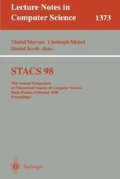Abstract
As a natural restriction of disguised Horn functions (i.e., Boolean functions which become Horn after a renaming (change of polarity) of some of the variables), we consider the class C DH R of disguised double Horn functions, i.e., the functions which and whose complement are both disguised Horn. We investigate the syntactical properties of this class and relationship to other classes of Boolean functions. Moreover, we address the extension problem of partially defined Boolean functions (pdBfs) in C DH R, where a pdBf is a function defined on a subset (rather than the full set) of Boolean vectors. We show that the class C DH R coincides with the class C 1–DL of 1-decision lists, and with the intersections of several well-known classes of Boolean functions. Furthermore, polynomial time algorithms for the recognition of a function in C DH R from Horn formulas and other classes of formulas are provided, while the problem is intractable in general. We also present an algorithm for the extension problem which, properly implemented, runs in linear time.
Preview
Unable to display preview. Download preview PDF.
References
H. Aizenstein, T. Hegedüs, L. Hellerstein and L. Pitt, Complexity theoretic hardness results for query learning, to appear in Journal of Complexity.
D. Angluin, M. Frazier, and L. Pitt, Learning conjunctions of Horn clauses, Machine Learning, 9:147–164, 1992.
M. Anthony and N. Biggs, Computational Learning Theory, Cambridge University Press, 1992.
M. Anthony, G. Brightwell and J. Shawe-Taylor, On specifying Boolean functions by labelled examples, Discr. Appl. Math., 61:1–25, 1995.
B. Aspvall, Recognizing disguised NR(1) instance of the satisfiability problem, J. Algorithms, 1:97–103, 1980.
E. Boros, T. Ibaraki and K. Makino, Error-free and best-fit extensions of partially defined Boolean functions, RUTCOR RRR 14-95, Rutgers University, 1995. Information and Computation, to appear.
S. Ceri, G. Gottlob, L. Tanca, Logic Programming and Databases, Springer, 1990.
Y. Crama, P. L. Hammer and T. Ibaraki, Cause-effect relationships and partially defined Boolean functions, Annals of Operations Research, 16:299–326, 1988.
D. W. Dowling and J.H. Gallier, Linear-time algorithms for testing the satisfyability of propositional Horn formulae, J. Logic Programming, 3:267–284, 1984.
T. Eiter, Generating Boolean μ-expressions, Acta Informatica, 32:171–187, 1995.
T. Eiter, T. Ibaraki, and K. Makino, Multi-Face Horn Functions, CD-TR 96/95, CD Lab for Expert Systems, TU Vienna, Austria, iii + 97 pages, 1996.
T. Eiter, T. Ibaraki, and K. Makino, Double Horn functions, RUTCOR Research Report RRR 18–97, Rutgers University 1997; to appear in Information and Computation.
T. Eiter, T. Ibaraki, and K. Makino, Two-face Horn extensions, to appear in Proceedings of ISAAC'97, Springer LNCS.
O. Ekin, P.L. Hammer and U. N. Peled, Horn functions and submodular Boolean functions, Theoretical Computer Science, 175(2):257–270, 1997.
S. A. Goldman, On the complexity of teaching, J. Computer and System Sciences, 50:20–31, 1995.
M. Golumbic, P.L. Hammer, P. Hansen, and T. Ibaraki (eds), Horn Logic, search and satisfiability, Annals of Mathematics and Artificial Intelligence 1, 1990.
H. Hunt III and R. Stearns, The complexity of very simple Boolean formulas with applications, SIAM J. Computing, 19:44–70, 1990.
H. A. Kautz, M. J. Kearns, and B. Selman, Horn approximations of empirical data, Artificial Intelligence, 74:129–145, 1995.
H. Lewis, Renaming a set of clauses as a Horn set, JACM, 25:134–135, 1978.
K. Makino, K. Hatanaka and T. Ibaraki, Horn extensions of a partially defined Boolean function, RUTCOR RRR 27-95, Rutgers University, 1995.
S. Muroga, Threshold Logic and Its Applications, Wiley-Interscience, 1971.
R. L. Rivest, Learning decision lists, Machine Learning, 2:229–246, 1996.
B. Selman and H. J. Levesque, Support set selection for abductive and default reasoning, Artificial Intelligence, 82:259–272, 1996.
Author information
Authors and Affiliations
Editor information
Rights and permissions
Copyright information
© 1998 Springer-Verlag
About this paper
Cite this paper
Eiter, T., Ibaraki, T., Makino, K. (1998). On disguised double horn functions and extensions. In: Morvan, M., Meinel, C., Krob, D. (eds) STACS 98. STACS 1998. Lecture Notes in Computer Science, vol 1373. Springer, Berlin, Heidelberg. https://doi.org/10.1007/BFb0028548
Download citation
DOI: https://doi.org/10.1007/BFb0028548
Published:
Publisher Name: Springer, Berlin, Heidelberg
Print ISBN: 978-3-540-64230-5
Online ISBN: 978-3-540-69705-3
eBook Packages: Springer Book Archive

